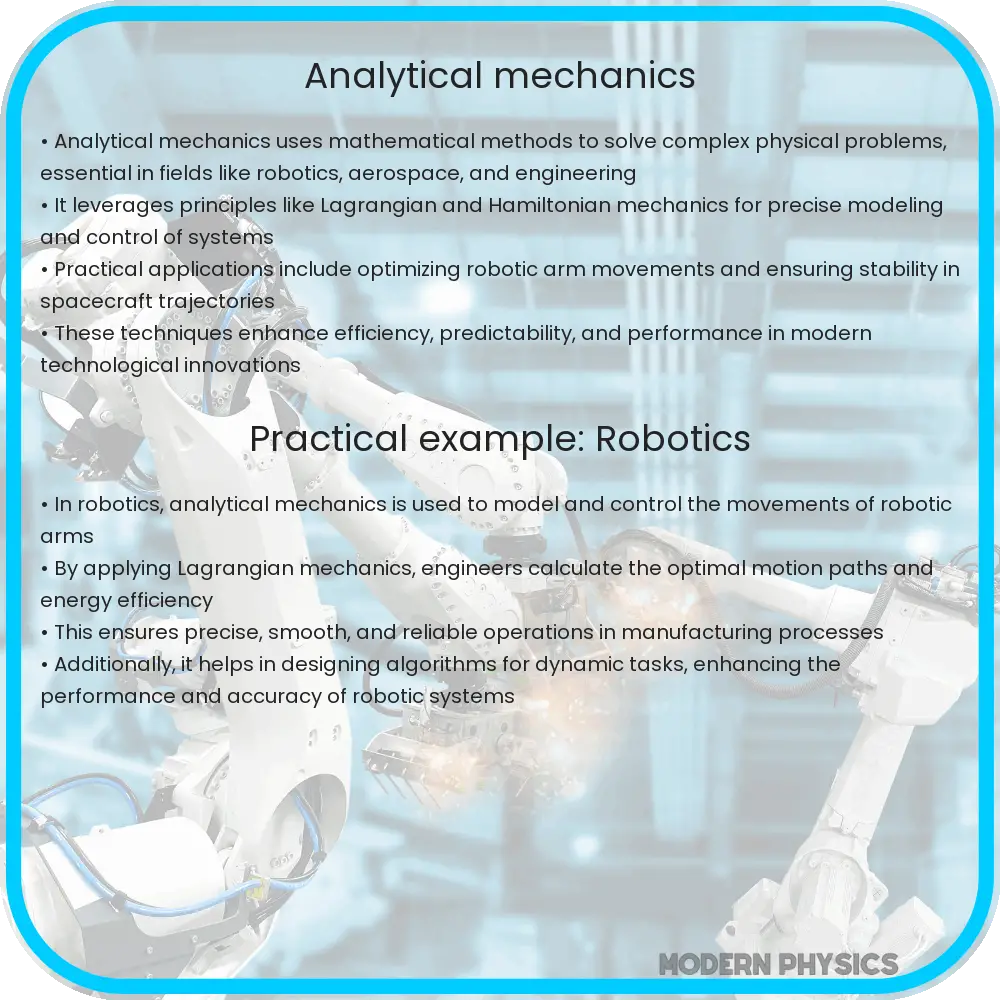Discover the fundamentals of Analytical Mechanics, including key concepts like Lagrangian and Hamiltonian mechanics, and explore its practical applications across various fields. Learn about subcategories such as rigid body dynamics, fluid mechanics, and chaos theory.

Understanding the Basics of Analytical Mechanics
Analytical mechanics is a branch of theoretical physics that utilizes mathematical frameworks to analyze the behavior of physical systems. It provides an alternative formulation to classical Newtonian mechanics, focusing on the use of calculus of variations to derive equations of motion. Central to this approach are the principles of Lagrangian and Hamiltonian mechanics, which offer powerful methods for studying both simple and complex systems.
Key Principles of Analytical Mechanics
Lagrangian Mechanics
Lagrangian mechanics is based on the principle of least action, where the path taken by a system between two states is the one that minimizes the action. The Lagrangian function, (where is kinetic energy and is potential energy), is fundamental in this formulation. Euler-Lagrange equations derived from this principle provide the equations of motion for the system.
Hamiltonian Mechanics
Hamiltonian mechanics reformulates classical mechanics using the Hamiltonian function, . This approach is particularly useful for studying systems in phase space, providing insights into their temporal evolution. Hamilton’s equations, derived from the Hamiltonian, are crucial for understanding the dynamics of both classical and quantum systems.
Applications of Analytical Mechanics
Engineering
In engineering, analytical mechanics is applied to design and analyze mechanical systems, ensuring stability and performance. It aids in understanding the dynamics of structures, machinery, and vehicles, facilitating advancements in design and innovation.
Physics
Analytical mechanics underpins many areas of physics, from classical mechanics to quantum mechanics. It provides the mathematical tools necessary for exploring theoretical concepts and solving complex physical problems. Its principles are essential for studying the behavior of particles, fields, and waves.
Space Exploration
Analytical mechanics plays a vital role in space exploration, enabling precise calculations for satellite orbits, interplanetary missions, and spacecraft trajectories. It allows scientists to predict and control the motion of celestial bodies, ensuring successful space missions.
Conservation Laws
An important area in Analytical Mechanics not yet mentioned is the study of Conservation Laws. These laws, such as the conservation of energy, momentum, and angular momentum, are fundamental principles that arise naturally from the symmetries in physical systems. Noether’s theorem, which connects symmetries and conservation laws, is a pivotal result in this context. Understanding these principles is crucial for analyzing the behavior of physical systems, predicting their future states, and solving complex problems in both classical and modern physics.
Modern Applications of Analytical Mechanics
Quantum Computing: Analytical mechanics principles, particularly Hamiltonian mechanics, are crucial in developing algorithms for quantum computers.
Robotics: Lagrangian mechanics is used to model and control the movement and dynamics of robotic systems, improving precision and efficiency.
Astrophysics: Analytical mechanics helps in simulating the dynamics of celestial bodies and predicting cosmic events.
Biomechanics: Applied to understand the motion and forces within biological systems, aiding in medical diagnostics and prosthetics design.
Advanced Materials Science: Used in the analysis of the mechanical properties of new materials, leading to innovations in engineering and technology.
These applications demonstrate the versatility and essential role of analytical mechanics in advancing modern technology and science.
Additional Applications of Analytical Mechanics
Control Theory: Analytical mechanics principles, such as Lagrangian and Hamiltonian formulations, are employed to develop control systems for various engineering applications, including aerospace and automotive industries.
Seismology: Used to model and predict the behavior of seismic waves during earthquakes, aiding in the design of structures that can withstand seismic activity.
Acoustics: Analytical mechanics helps in understanding sound wave propagation, designing better acoustic devices, and improving noise control measures.
Plasma Physics: Applied to study the dynamics of charged particles in plasmas, which is essential for both astrophysical research and controlled nuclear fusion efforts.
Economic Modeling: Concepts from analytical mechanics, such as optimization and equilibrium, are increasingly being used to model complex economic systems and predict market behaviors.
These applications highlight the broad and impactful scope of analytical mechanics in both traditional and emerging fields.
Conclusion
Analytical mechanics stands as a cornerstone of theoretical physics and engineering, providing a robust mathematical framework for understanding the complexities of physical systems. Its core principles, Lagrangian and Hamiltonian mechanics, offer profound insights into the dynamics of both classical and modern systems. The applications of analytical mechanics are vast and diverse, ranging from traditional fields like engineering, physics, and space exploration to modern advancements in quantum computing, robotics, and biomechanics.
In engineering, analytical mechanics ensures the stability and performance of mechanical systems, aiding in the design and analysis of structures, machinery, and vehicles. In physics, it underpins many fundamental theories, offering the mathematical tools necessary to explore theoretical concepts and solve complex problems. Its principles are also essential in space exploration, enabling precise calculations for satellite orbits and spacecraft trajectories.
Beyond these traditional applications, analytical mechanics plays a critical role in modern technologies. Quantum computing leverages Hamiltonian mechanics to develop advanced algorithms, while robotics uses Lagrangian mechanics to enhance the precision and efficiency of robotic systems. In the field of biomechanics, the principles of analytical mechanics help in understanding the forces and motions within biological systems, leading to improvements in medical diagnostics and prosthetics design.
Furthermore, analytical mechanics finds applications in control theory, seismology, acoustics, plasma physics, and even economic modeling. Its versatility and mathematical rigor make it an indispensable tool for advancing our understanding of the natural world and driving technological innovation.
In conclusion, analytical mechanics not only enriches our comprehension of physical laws but also empowers us to harness these principles for practical and transformative applications. As we continue to explore and innovate, the principles of analytical mechanics will remain at the forefront of scientific and technological progress, guiding us toward new discoveries and solutions.
